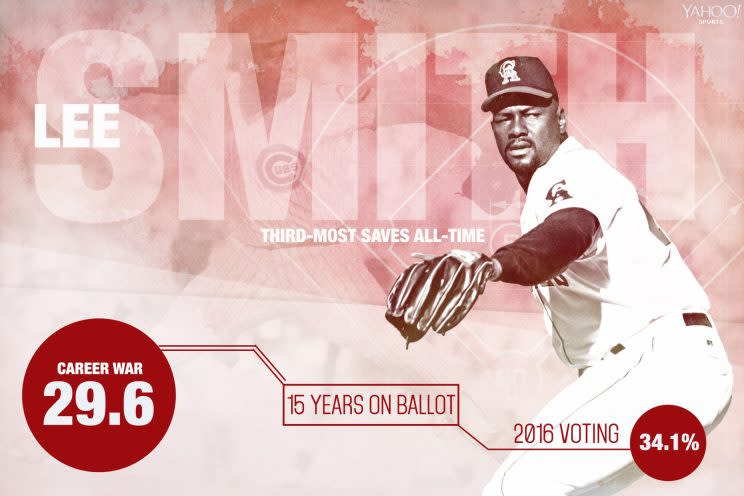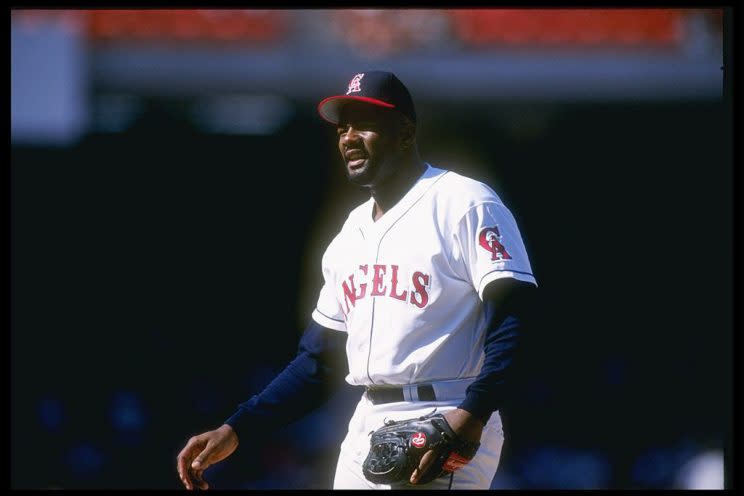Lee Smith: Is he a Hall of Famer?
Baseball is a game that changes faster than we think. While the fight for instant replay was highlighted for years, managers can start a revolution without getting anyone’s permission. When Lee Smith began his career as a reliever, he (like other relievers) was often deployed for more than one inning at a time. Sure, he’d appear for one inning every now and then, but getting saves of more than three outs was the norm at the time. But it didn’t stay that way forever. In the early 90s, closers started taking the mound for just one inning and getting three outs instead of four to six or more. That’s the way things are largely done today.
That change is really at the crux of Smith’s Hall of Fame case, as chunks of his career were spent in both eras of closer deployment. And with such a change, the way people (i.e. writers and voters) value closers changed. They pitch in high leverage situations, but their outings are shorter than they were, leading to a decrease in value.
So how does Lee Smith’s case for Cooperstown shake out? Let’s take a look.

PREVIOUSLY
This is Lee Smith’s 15th year on the ballot. While the current limit for players is 10 years, Smith was grandfathered in when that change was made in 2014, allowing him to appear for the previous maximum of 15 years. And in that 15 years, his support has gone up and down. He debuted in 2003 with a very respectable 42.3 percent, and since then has consistently gotten between 37 and 50 percent. He peaked in 2012 at 50.6 percent
According to Ryan Thibodaux’s indispensable ballot tracker, it’s bad news for Smith. Of the 200 ballots he’s tracked, Smith has received 58 votes. He needs another 269 to get to 75%, but there are only about 235 ballots left outstanding. That means he won’t make it into the Hall on his final year on the ballot, and then it’ll be left to one of the Era Committees to decide if he deserves a plaque.
WHAT THE SUPPORTERS SAY
When looking at Lee Smith, it’s important to remember the era he pitched in, and how closers were used at the time. When Smith would close a game, it was often for more than one inning, which is why it took him more innings to get to 478 saves than it took Trevor Hoffman to get to the same number. When Smith retired in 1997, he did so with a lifetime ERA of 3.03, 1289.1 innings pitched, and 1,250 strikeouts.
Smith became MLB’s all-time saves leader in 1993, and when he retired he had racked up 478 career saves. He was the saves leader until 2006, when Trevor Hoffman hit 478 and just kept on going. In the 20 years since Smith has retired, only two people have passed him on that list, which says a lot about Smith’s accomplishments. Smith also deserves credit for adapting his game when the philosophy about relief pitchers was changing. He transitioned from a multi-inning guy to a one-inning guy, and saw his yearly saves total take a huge leap upwards. In 1990, Smith pitched 83 innings and notched 31 saves.

WHAT THE SKEPTICS SAY
It’s never easy for relievers to make their way into the Hall of Fame. The first one was inducted in 1985, and there have only been five total pitchers enshrined who were primarily relievers. Hall of Fame voters have a difficult time valuing relievers, and it shows. So despite his once-gaudy saves number, Lee always had an uphill battle to get into the Hall.
Lee retired in 1997, and the game had already changed for closers. In the last several years of his career, he started experiencing the one-inning limited usage model for closers that would become the industry norm. Smith is still high on the all-time saves list, but Trevor Hoffman passed him in 2006, and Mariano Rivera passed them both in 2011. In some ways, Smith’s a victim of the changing role of relievers that happened in the waning years of his career. Next to Hoffman and Rivera, his saves total doesn’t look as impressive as it once did.
Beyond saves alone, a few of his rate stats don’t quite measure up. For relievers with more than 200 saves, he’s not in the top ten in strikeouts per nine innings. Looking at WHIP for the same group, Smith isn’t in the top 20. Obviously none of this says that Smith wasn’t good, because he was very good for a long stretch of time. But he’s just not quite good enough for the Hall of Fame voters.

OUR BALLOTS
The Big League Stew writers don’t have Hall of Fame votes, but if we did, here’s where we stand on Lee Smith:
Chris Cwik
No — Another tough one for me. Smith pitched right as reliever roles started changing. He threw a lot of innings early in his career, but eventually was deployed the same way closers get used today. As I said during Hoffman’s case, I have a hard time valuing relievers who pitched in that era. If I’m saying no on Hoffman, I feel I should also say no for Smith.
Mike Oz
No — Lee Smith was great and, in his 15th and final year on the ballot, it would be nice to give him an affirmative here, but I just can’t do it. He doesn’t quite measure up to the relievers who are already in the Hall in overall value. And while he was the all-times saves leader at one point, the era of true closers came and zoomed right past him. He’s almost stuck in a gap between two eras at his position. In the end, he’s close for me, but I’m saying Hall of Very Good instead of Hall of Fame.
Liz Roscher
No — I feel for Lee Smith and his Hall of Fame case. If he’d pitched entirely in one closer era instead of straddling both, I think he’d have a much stronger chance of making it in. But he pitched at a time when closer roles were undergoing a huge change. He adapted really well, but it did some damage to his Hall of Fame case. Regardless, he was an excellent closer, and hopefully one of the Era Committees will consider him in the future.
Mark Townsend
No — It’s tough saying no to Smith, but I’ve set the bar for relievers above Trevor Hoffman. Smith was among the best for a long, long time, but his overall body of work falls a little short.
ALSO IN THIS SERIES:
• Jeff Bagwell
• Barry Bonds
• Roger Clemens
• Vladimir Guerrero
• Trevor Hoffman
• Edgar Martinez
• Mike Mussina
• Jorge Posada
• Tim Raines
• Manny Ramirez
• Curt Schilling
More MLB coverage from Yahoo Sports:
The StewPod: A baseball podcast by Yahoo Sports
Subscribe via iTunes or via RSS feed
– – – – – –
Liz Roscher is a writer for Big League Stew on Yahoo Sports. Have a tip? Email her at lizroscher@yahoo.com or follow her on twitter! Follow @lizroscher

 Yahoo Sports
Yahoo Sports 
